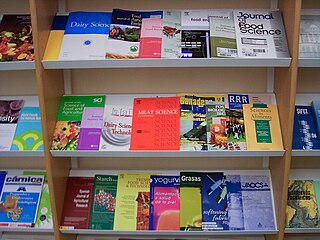
An academic journal or scholarly journal is a periodical publication in which scholarship relating to a particular academic discipline is published. Academic journals serve as permanent and transparent forums for the presentation, scrutiny, and discussion of research. They nearly universally require peer review or other scrutiny from contemporaries competent and established in their respective fields. Content typically takes the form of articles presenting original research, review articles, or book reviews. The purpose of an academic journal, according to Henry Oldenburg, is to give researchers a venue to "impart their knowledge to one another, and contribute what they can to the Grand design of improving natural knowledge, and perfecting all Philosophical Arts, and Sciences."
A citation index is a kind of bibliographic index, an index of citations between publications, allowing the user to easily establish which later documents cite which earlier documents. A form of citation index is first found in 12th-century Hebrew religious literature. Legal citation indexes are found in the 18th century and were made popular by citators such as Shepard's Citations (1873). In 1961, Eugene Garfield's Institute for Scientific Information (ISI) introduced the first citation index for papers published in academic journals, first the Science Citation Index (SCI), and later the Social Sciences Citation Index (SSCI) and the Arts and Humanities Citation Index (AHCI). American Chemical Society converted its printed Chemical Abstract Service into internet-accessible SciFinder in 2008. The first automated citation indexing was done by CiteSeer in 1997 and was patented. Other sources for such data include Google Scholar, Microsoft Academic, Elsevier's Scopus, and the National Institutes of Health's iCite.

Sonic and ultrasonic weapons (USW) are weapons of various types that use sound to injure or incapacitate an opponent. Some sonic weapons make a focused beam of sound or of ultrasound; others produce an area field of sound. As of 2023 military and police forces make some limited use of sonic weapons.
Proceedings of the Royal Society is the main research journal of the Royal Society. The journal began in 1831 and was split into two series in 1905:
The Institute for Scientific Information (ISI) was an academic publishing service, founded by Eugene Garfield in Philadelphia in 1956. ISI offered scientometric and bibliographic database services. Its specialty was citation indexing and analysis, a field pioneered by Garfield.
The impact factor (IF) or journal impact factor (JIF) of an academic journal is a scientometric index calculated by Clarivate that reflects the yearly mean number of citations of articles published in the last two years in a given journal, as indexed by Clarivate's Web of Science.
Hyperacusis is the increased sensitivity to sound and a low tolerance for environmental noise. Definitions of hyperacusis can vary significantly; it can refer to normal noises being perceived as: loud, annoying, painful, fear-inducing, or a combination of those, and is often categorized into four subtypes: loudness, pain, annoyance, and fear.

Google Scholar is a freely accessible web search engine that indexes the full text or metadata of scholarly literature across an array of publishing formats and disciplines. Released in beta in November 2004, the Google Scholar index includes peer-reviewed online academic journals and books, conference papers, theses and dissertations, preprints, abstracts, technical reports, and other scholarly literature, including court opinions and patents.

The Journal of Organic Chemistry, colloquially known as JOC, is a peer-reviewed scientific journal for original contributions of fundamental research in all branches of theory and practice in organic and bioorganic chemistry. It is published by the publishing arm of the American Chemical Society, with 24 issues per year. According to the Journal Citation Reports, the journal had a 2017 impact factor of 4.805 and it is the journal that received the most cites in the field of organic chemistry. According to Web of Knowledge, eleven papers from the journal have received more than 1,000 citations, with the most cited paper having received 7,967 citations. The current editor-in-chief is Scott J. Miller from Yale University.
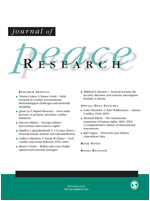
The Journal of Peace Research is a bimonthly peer-reviewed academic journal that publishes scholarly articles and book reviews in the fields of peace and conflict studies, conflict resolution, and international security. It was established by Johan Galtung in 1964 and has been published since 1998. Nils Petter Gleditsch was editor-in-chief from 1983 to 2010; between 2010 and 2017 the editor was Henrik Urdal, and as of July 2010 the editor is Gudrun Østby.

Cancer Research is a biweekly peer-reviewed medical journal published by the American Association for Cancer Research. It covers research on all aspects of cancer and cancer-related biomedical sciences and was established in 1941. The editor-in-chief is Chi Van Dang.
Journal Citation Reports (JCR) is an annual publication by Clarivate. It has been integrated with the Web of Science and is accessed from the Web of Science Core Collection. It provides information about academic journals in the natural and social sciences, including impact factors. The JCR was originally published as a part of the Science Citation Index. Currently, the JCR, as a distinct service, is based on citations compiled from the Science Citation Index Expanded and the Social Sciences Citation Index. As of the 2023 edition, journals from the Arts and Humanities Citation Index and the Emerging Sources Citation Index will also be included.

The American Journal of Public Health is a monthly peer-reviewed public health journal published by the American Public Health Association that covers health policy and public health. The journal was established in 1911 and its stated mission is "to advance public health research, policy, practice, and education." The journal occasionally publishes themed supplements. The editor-in-chief is Alfredo Morabia.
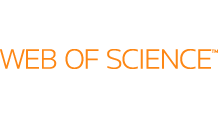
The Web of Science is a paid-access platform that provides access to multiple databases that provide reference and citation data from academic journals, conference proceedings, and other documents in various academic disciplines. It was originally produced by the Institute for Scientific Information. It is currently owned by Clarivate.

Current Biology is a biweekly peer-reviewed scientific journal that covers all areas of biology, especially molecular biology, cell biology, genetics, neurobiology, ecology, and evolutionary biology. The journal includes research articles, various types of review articles, as well as an editorial magazine section. The journal was established in 1991 by the Current Science group, acquired by Elsevier in 1998 and has since 2001 been part of Cell Press, a subdivision of Elsevier. According to Journal Citation Reports, the journal has a 2020 impact factor of 10.834. It was categorized as a "high impact journal" by the Superfund Research Program.
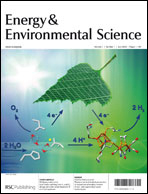
Energy & Environmental Science is a monthly peer-reviewed scientific journal publishing original (primary) research and review articles. The journal covers work of an interdisciplinary nature in the biochemical and biophysical sciences and chemical and mechanical engineering disciplines. It covers energy area. Energy & Environmental Science is published by the Royal Society of Chemistry and the editor-in-chief is Joseph Hupp.
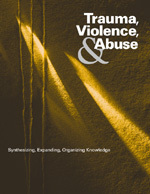
Trauma, Violence, & Abuse is a peer-reviewed academic journal that covers research on trauma, abuse, and violence. The journal's editor-in-chief is Jon R. Conte. It was established in 2000 and is currently published by SAGE Publications.
Author-level metrics are citation metrics that measure the bibliometric impact of individual authors, researchers, academics, and scholars. Many metrics have been developed that take into account varying numbers of factors.
The Journal of Speech, Language, and Hearing Research is a monthly online-only peer-reviewed scientific journal covering all aspects of interpersonal communication. It was established in 1936 as the Journal of Speech and Hearing Disorders, which was merged with the Journal of Speech and Hearing Research to form the Journal of Speech and Hearing Research in 1991. The word "Language" was added to the title in 1997. It is published by the American Speech–Language–Hearing Association and the editors-in-chief are Bharath Chandrasekaran, Sean Redmond, and Frederick Gallun. According to the Journal Citation Reports, the journal has a 2017 impact factor of 1.906, ranking it 8th out of 25 journals in the category "Audiology and Speech-Language Pathology".
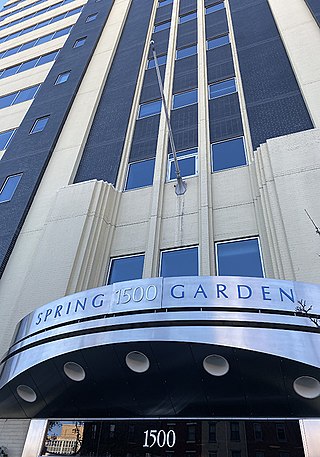
Clarivate Plc is a British-American publicly traded analytics company that operates a collection of subscription-based services, in the areas of bibliometrics and scientometrics; business / market intelligence, and competitive profiling for pharmacy and biotech, patents, and regulatory compliance; trademark protection, and domain and brand protection. In the academy and the scientific community, Clarivate is known for being the company which calculates the impact factor, using data from its Web of Science product family, that also includes services/applications such as Publons, EndNote, EndNote Click, and ScholarOne. Its other product families are Cortellis, DRG, CPA Global, Derwent, MarkMonitor, CompuMark, and Darts-ip, and also the various ProQuest products and services.











